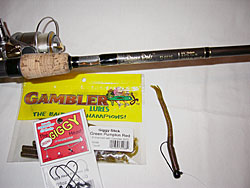
National tournament circuits have generated much publicity for jig worming as of late (often called the shaky head). With field sizes increasing, tour practice periods decreasing, and pressure on bass at an all-time high, the rise in popularity of the jig worm is not surprising. The technique, also known as shaky head worming, catches fish when others fail. Virtually every large-scale tackle manufacturer has a finesse line of soft plastics, many of those geared towards jig worming, so choosing the most effective lure for a given situation is a daunting task at best.
When looking at a specific application for the jig worm, an angler must know what characteristics make it effective. To stereotype, jig worming is a "sissy" technique, often viewed as dull and boring. It does not involve running around the lake and covering vast amounts of water to put bass in the boat. Instead, it requires patience, careful equipment and lure selection, and attention to fine detail. When one of these components is overlooked, the jig worm loses its value.
Slow is Not Enough
The discipline required in fishing the jig worm is similar to that of a competitive runner. Starting too fast will cause fatigue down the road. Although the form experienced by an angler is more mental than anything else, fatigue will lead to a lack of concentration and an unintentional acceleration in covering water. On the other hand, starting slow and attempting to work even slower will further increase the technique's success. The focus of fishing is often on the future and not the present, meaning that anglers frequently think ahead to the next cast or spot. And it's not surprising that this occurs.
Given the limited amount of time during a tournament or recreational outing, the pressure is on the angler to produce instantaneous results. One method to slow the cast-and-wind tendency is to make mental notes of the angling surroundings. Doing this maintains focus on the present. Water temperature, wind direction, weedline contour, bottom composition, sunlight intensity, and boat position are all valuable data that will benefit in the long run.
Covering water with electronics before placing the initial cast also forces an angler to concentrate on one particular area at a time. Then, when the correct frame of mind is established, an angler is prepared to put the finesse equipment into action.
Sissy Sticks
Fishing a jig worm requires much of the same gear as conventional worm fishing. However, light line selection necessitates using a fast-action rod that does not sacrifice sensitivity. Rod power is saved when utilizing a fast-action rod for a given length. In turn, lesser power improves the handling of light lines, while the fast action allows the lure to be cast into the periphery of the weeds and popped free of any nuisance vegetation. The snapping serves a purpose as it imparts an abrupt, attention-grabbing movement underwater.
Another important consideration when selecting a jig worming rod is length. Longer rods are advantageous because more line is displaced in a single motion. That movement not only eases the effort in snapping but also generates slack and guarantees lure free fall to deep bottoms. St. Croix manufactures the Legend Tournament line of spinning rods that combines a fast action with sensitive blanks. The 7' 1" medium-fast Legend Tournament rod offers excellent versatility to cover most jig worm situations. In addition, St. Croix's premium Fuji K-Series tangle-free guides with Alconite inserts impart proper rod balance and casting accuracy. In summary, selecting the most appropriate rod for a particular jig-worming scenario will maximize the lure's effectiveness.
The Giggy Head

Jig worm heads and lures are available in many forms. Function, design, and performance vary with each manufacturer. However, Gambler Lures offers a complete line of finesse plastics specifically tailored for jig worming. The namesake Giggy Head is designed exclusively for the jig-worming aficionado. Threaded with the Gambler Giggy Stick, Icesickle worm, and Giggy Finesse Snake, the jig utilizes a mushroom-shaped head to ensure upright landings.
The Giggy Stick incorporates the shape of a finesse worm with the buoyancy of a hollow tube. A small diameter shaft permits air to be trapped in the body, so the tail remains upright on the fall and at rest. Meanwhile, solid head construction provides for secure pegging and weedless rigging. Finally, the lure barb design allows the bait to break free without fouling the hook - a significant disadvantage with corkscrew keepers.
Attention to Detail
Light line is synonymous with jig worming, and rightfully so. Smaller diameter lines are less visible to bass. Fluorocarbon lines further improve presentation stealth. Regardless of the line type, knot location influences the jig worm presentation. The jig appears relatively horizontal in the water if a knot is slid closer to the top. However, this knot location does help to improve snag resistance upon retrieval. When the knot is slid in the opposite direction towards the hook point, the jig will stabilize in a more vertical posture on the bottom.
Revolutionary advancements in sonar technology, specifically side, down, and forward imaging, simplify the search for underwater subtleties - a once laborious chore in jig worming. The time saved while surveying the water with modern equipment now leads to a slower, more effective presentation. The Humminbird side imaging units display weedline edges, brushpiles, bottom composition changes, and other underwater structures in incredible detail. High-frequency sonar propagates from both sides of the transducer, and the reflected waves create "shadows" of objects on display. Side imaging even provides a fresh perspective on angling community holes. That knowledge, combined with the jig worming technique, helps to coax even the wariest bass into biting.
A Technique to Try
Jig worming is a technique to try when other presentations fail. Armed with the proper patience, equipment, and lures, any angler can adapt to a broader range of conditions. So the next time you find yourself tired from running around the lake, pick up the Sissy Stick and go after some Giggy Bass!




